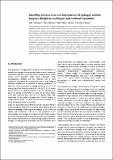Por favor, use este identificador para citar o enlazar a este item:
http://hdl.handle.net/10261/170807COMPARTIR / EXPORTAR:
 SHARE SHARE
 CORE
BASE CORE
BASE
|
|
| Visualizar otros formatos: MARC | Dublin Core | RDF | ORE | MODS | METS | DIDL | DATACITE | |

| Título: | Modelling of adsorption and intercalation of hydrogen on/into tungsten disulphide multilayers and multiwall nanotubes |
Autor: | Martínez, José I. CSIC ORCID ; Laikhtman, Alexander; Moon, Hoi Ri; Zak, Alla; Alonso, J. A. CSIC ORCID | Fecha de publicación: | 13-abr-2018 | Editor: | Royal Society of Chemistry (UK) | Citación: | Physical Chemistry Chemical Physics 20(17): 12061- 2074 (2018) | Resumen: | Understanding the interaction of hydrogen with layered materials is crucial in the fields of sensors, catalysis, fuel cells and hydrogen storage, among others. Density functional theory, improved by the introduction of van der Waals dispersion forces, provides an efficient and practical workbench to investigate the interaction of molecular and atomic hydrogen with WS2 multilayers and nanotubes. We find that H2 physisorbs on the surface of those materials on top of W atoms, while atomic H chemisorbs on top of S atoms. In the case of nanotubes, the chemisorption strength is sensitive to the nanotube diameter. Diffusion of H2 on the surface of WS2 encounters quite small activation barriers whose magnitude helps to explain previous and new experimental results for the observed dependence of the hydrogen concentration with temperature. Intercalation of H2 between adjacent planar WS2 layers reveals an endothermic character. Intercalating H atoms is energetically favorable, but the intercalation energy does not compensate for the cost of dissociating the molecules. When H2 molecules are intercalated between the walls of a double wall nanotube, the rigid confinement induces the dissociation of the confined molecules. A remarkable result is that the presence of a full H2 monolayer adsorbed on top of the first WS2 layer of a WS2 multilayer system strongly facilitates the intercalation of H2 between WS2 layers underneath. This opens up an additional gate to intercalation processes. | Versión del editor: | https://doi.org/10.1039/C8CP01437J | URI: | http://hdl.handle.net/10261/170807 | DOI: | 10.1039/C8CP01437J | ISSN: | 1463-9076 | E-ISSN: | 1463-9084 |
| Aparece en las colecciones: | (ICMM) Artículos |
Ficheros en este ítem:
| Fichero | Descripción | Tamaño | Formato | |
|---|---|---|---|---|
| Martinez_Modelling_JIM_PCCP2018.pdf | 12,66 MB | Adobe PDF |  Visualizar/Abrir |
CORE Recommender
WEB OF SCIENCETM
Citations
4
checked on 27-feb-2024
Page view(s)
315
checked on 23-abr-2024
Download(s)
251
checked on 23-abr-2024
Google ScholarTM
Check
Altmetric
Altmetric
NOTA: Los ítems de Digital.CSIC están protegidos por copyright, con todos los derechos reservados, a menos que se indique lo contrario.
